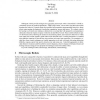Free Online Productivity Tools
i2Speak
i2Symbol
i2OCR
iTex2Img
iWeb2Print
iWeb2Shot
i2Type
iPdf2Split
iPdf2Merge
i2Bopomofo
i2Arabic
i2Style
i2Image
i2PDF
iLatex2Rtf
Sci2ools
111
Voted
AAMAS
2007
Springer
2007
Springer
Coordinating microscopic robots in viscous fluids
Multiagent control provides strategies for aggregating microscopic robots (“nanorobots”) in fluid environments relevant for medical applications. Unlike larger robots, viscous forces and Brownian motion dominate the behavior. Examples range from modified microorganisms (programmable bacteria) to future robots using ongoing developments in molecular computation, sensors and motors. We evaluate controls for locating a cell-sized area emitting a chemical into a moving fluid with parameters corresponding to chemicals released in response to injury or infection in small blood vessels. These control methods are passive Brownian motion, following the chemical concentration gradient, and cooperative behaviors in which some robots use acoustic signals to guide others to the chemical source. Control performance is evaluated using diffusion equations to describe the robot motions and control state transitions. The quantitative results show these control techniques are feasible approaches ...
| Added | 08 Dec 2010 |
| Updated | 08 Dec 2010 |
| Type | Journal |
| Year | 2007 |
| Where | AAMAS |
| Authors | Tad Hogg |
Comments (0)

